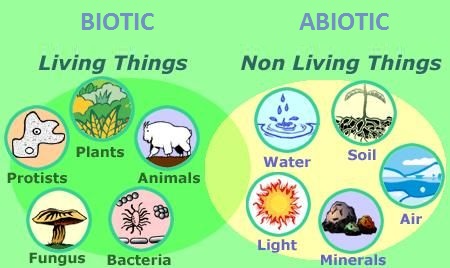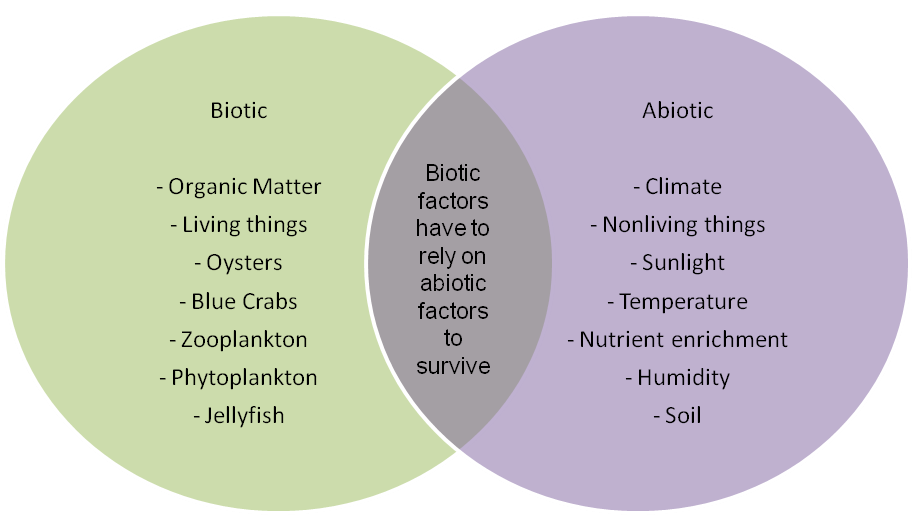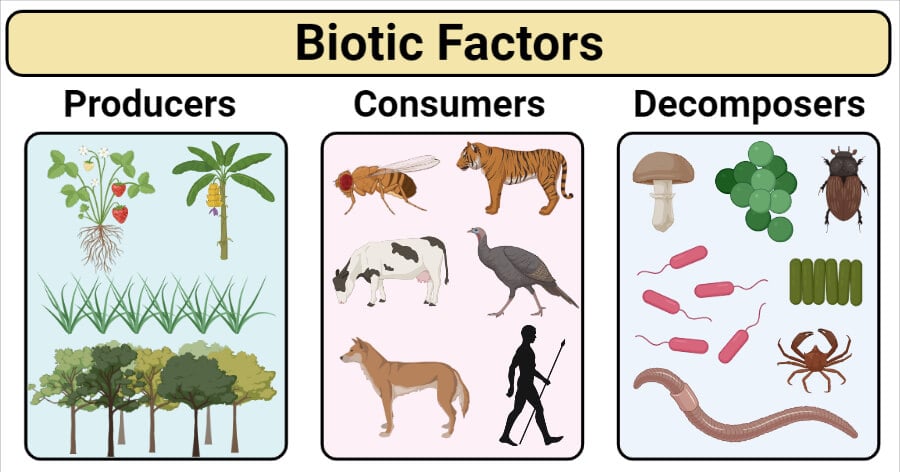Topic ecosystem abiotic and biotic components: Explore the intricate dance between abiotic and biotic components within ecosystems, understanding their crucial roles in sustaining life and biodiversity on Earth.
Table of Content
- What are the components of an ecosystem, including both biotic and abiotic factors?
- Understanding Ecosystems: Abiotic and Biotic Components
- Defining Abiotic Factors: Essential Non-Living Elements
- Exploring Biotic Factors: The Role of Living Organisms
- Interactions Between Abiotic and Biotic Components
- Examples of Abiotic Factors: Water, Soil, and Climate
- YOUTUBE: Biotic and Abiotic Factors in an Ecosystem
- Examples of Biotic Factors: Flora and Fauna
- Impact of Abiotic Factors on Biotic Components
- Adaptations of Living Organisms to Abiotic Conditions
- The Significance of Energy Flow and Nutrient Cycles
- Case Studies: Diverse Ecosystems and Their Components
- Conservation Efforts: Protecting the Balance of Ecosystems
What are the components of an ecosystem, including both biotic and abiotic factors?
An ecosystem is a complex system that consists of both biotic and abiotic components. Biotic components refer to the living organisms within an ecosystem, while abiotic components refer to the non-living factors. Let\'s explore the components of an ecosystem in more detail:
Biotic Components:
- Plants: Plants play a crucial role in the ecosystem as they are the primary producers. They convert sunlight into energy through photosynthesis, providing food for other organisms.
- Animals: Animals are integral parts of ecosystems. They can be classified into different trophic levels, including consumers (herbivores, carnivores, omnivores) and decomposers (such as bacteria and fungi).
- Microorganisms: Microorganisms, such as bacteria and fungi, are essential for nutrient cycling and decomposition processes in ecosystems. They play a significant role in breaking down organic matter.
- Humans: In some ecosystems, human activities can have a significant impact. Human interventions can alter the balance of biotic components and disrupt the natural functioning of the ecosystem.
Abiotic Components:
- Climate: Climate encompasses factors like temperature, precipitation, wind patterns, and sunlight availability. These factors shape the overall environmental conditions within an ecosystem.
- Water: The availability of water is a vital abiotic factor for an ecosystem. It determines the types of organisms that can survive and thrive in a particular ecosystem.
- Soil: Soil properties, such as nutrient content, pH level, and texture, influence the growth of plants and the overall productivity of the ecosystem.
- Geology: The underlying geology of an area can affect the availability of nutrients and minerals in the ecosystem. It also determines the formation of landforms like mountains and valleys.
- Atmosphere: The composition of gases in the atmosphere, including oxygen, carbon dioxide, and nitrogen, can impact the types of organisms that can survive in a particular ecosystem.
All of these biotic and abiotic components are interconnected and interact with each other within an ecosystem. Changes in one component can have cascading effects throughout the ecosystem, highlighting the delicate balance that exists within these systems.
READ MORE:
Understanding Ecosystems: Abiotic and Biotic Components
Ecosystems are dynamic systems defined by the intricate interactions between abiotic (non-living) and biotic (living) components. These interactions form a complex web that supports life, maintains ecological balance, and drives the processes of energy flow and nutrient cycling. Understanding these components is key to appreciating the richness and diversity of life on Earth.
- Abiotic Components: These include physical and chemical factors such as sunlight, temperature, water, atmospheric gases, and soil. Abiotic factors set the stage for the ecosystem"s structural foundation, influencing climate, geography, and habitat suitability for living organisms.
- Biotic Components: Encompassing all living organisms within the ecosystem, from microscopic bacteria to large mammals. Biotic components are categorized into producers (autotrophs), consumers (heterotrophs), and decomposers (detritivores), each playing vital roles in energy transfer and nutrient cycling.
The interaction between abiotic and biotic components shapes the ecosystem"s characteristics and determines its capacity to support life. For example, sunlight (an abiotic factor) drives photosynthesis in plants (a biotic factor), which in turn provides oxygen and food for other organisms. Similarly, soil quality (abiotic) affects plant growth (biotic), which provides habitat and food for animals.
- Producers: Organisms like plants and algae that convert abiotic resources (e.g., sunlight and CO2) into food energy through photosynthesis.
- Consumers: Animals and organisms that eat other organisms for energy. They are divided into primary, secondary, and tertiary consumers, depending on their place in the food chain.
- Decomposers: Fungi and bacteria that break down dead organisms, returning nutrients to the soil and completing the nutrient cycle.
Understanding the balance and interaction between abiotic and biotic components is crucial for conservation efforts and sustainable environmental management. By recognizing the importance of each component, we can better appreciate the complexity of ecosystems and the necessity of preserving biodiversity for the health of our planet.

Defining Abiotic Factors: Essential Non-Living Elements
Abiotic factors play a critical role in shaping ecosystems, providing the non-living foundation that influences the survival, growth, and distribution of organisms. These factors include:
- Climate: Encompassing temperature, humidity, sunlight, and wind patterns that affect living conditions.
- Water: Essential for life, affecting species distribution based on availability and quality.
- Soil: Comprising various types that provide nutrients, support, and habitat to different life forms.
- Minerals: Nutrients found in the soil that are crucial for plant growth and thus indirectly for animals through the food chain.
- Topography: The physical layout of the land that can influence ecosystem dynamics through elevation, slope, and aspect.
- Atmospheric gases: Including oxygen, carbon dioxide, and nitrogen, which are vital for photosynthesis, respiration, and other life processes.
These abiotic components interact with biotic elements, creating the diverse ecosystems we see across the globe.
Exploring Biotic Factors: The Role of Living Organisms
Biotic factors encompass all living components of an ecosystem, which interact with each other and with their abiotic counterparts to sustain life. These include plants, animals, bacteria, fungi, and any other living organisms. Understanding their roles offers insights into the complexity of ecosystems and their functioning.
- Producers (Autotrophs): These are organisms that produce their own food through photosynthesis or chemosynthesis, forming the base of the ecosystem"s food web.
- Consumers (Heterotrophs): Organisms that consume other organisms for energy. They are classified into primary, secondary, and tertiary consumers, depending on their diet.
- Decomposers: These organisms, including bacteria and fungi, break down dead organic matter, returning essential nutrients to the soil, which are then reused by producers.
The interplay between these biotic factors creates a dynamic web of life that supports diverse ecosystems. By understanding the roles and relationships of living organisms within their habitats, we can appreciate the delicate balance necessary for ecosystem health and stability.

Interactions Between Abiotic and Biotic Components
The seamless interactions between abiotic and biotic components form the cornerstone of ecosystem functionality. These interactions are crucial for nutrient cycling, energy flow, and the overall health of the ecosystem. Here"s a closer look at how these components interrelate:
- Energy Flow: Abiotic factors like sunlight play a pivotal role in photosynthesis, the process by which plants (biotic components) convert light energy into chemical energy. This energy is then transferred through the ecosystem via food chains and webs, involving various biotic interactions.
- Nutrient Cycling: Decomposers, a key biotic component, break down dead organisms and waste materials, releasing nutrients back into the soil, water, and air—abiotic components—thus facilitating nutrient cycling.
- Habitat Formation: Abiotic factors such as water, soil, and climate determine the habitat"s characteristics, influencing the distribution and behavior of living organisms within it.
- Pollination and Seed Dispersal: Animals and insects (biotic factors) interact with plants (also biotic) in pollination and seed dispersal processes, crucial for plant reproduction and the spread of biotic components across the ecosystem.
- Regulation of Populations: Abiotic factors like temperature and precipitation influence the survival, reproduction, and distribution of organisms, directly affecting population dynamics within the ecosystem.
Understanding these interactions highlights the intricate balance and dependency between abiotic and biotic components, underscoring the complexity and resilience of ecosystems.
Examples of Abiotic Factors: Water, Soil, and Climate
Abiotic factors are the non-living parts of an ecosystem that have a significant impact on the environment and the organisms within it. Key examples include water, soil, and climate, each playing a unique role in shaping ecosystems:
- Water: Essential for all living organisms, water is a critical abiotic factor. It is involved in regulating temperature, transporting nutrients, and serving as a habitat for aquatic life.
- Soil: Comprising minerals, organic matter, and organisms, soil supports plant life by providing nutrients, water, and a medium for root development. The type and quality of soil influence the types of plants that can grow, thus affecting the entire ecosystem.
- Climate: Defined by long-term patterns of temperature, humidity, wind, and rainfall, climate determines the overall environment of an ecosystem. It influences the types of ecosystems that can exist in an area, the species that can survive, and the productivity of an ecosystem.
These abiotic factors interact with each other and with the biotic components of ecosystems, creating a complex web of life that is both diverse and interdependent. Understanding the role and impact of water, soil, and climate helps us appreciate the delicate balance maintained within natural ecosystems.

Biotic and Abiotic Factors in an Ecosystem
Components: Discover the key components that make up the foundation of this groundbreaking invention. Dive into this captivating video where experts break down each component and reveal the powerful role they play in creating something truly extraordinary.
Biotic and Abiotic Factors
Factors: Uncover the hidden factors that are shaping the future of innovation in this eye-opening video. Join us as we explore the critical factors that determine success and learn from visionary thinkers who have mastered the art of leveraging these factors to transform industries.
Examples of Biotic Factors: Flora and Fauna
Biotic factors encompass all living components of an ecosystem that influence the form and survival of other organisms. These include a wide range of flora (plants) and fauna (animals), each playing a unique role in the ecosystem"s health and stability. Here are some examples:
- Flora: Trees, shrubs, grasses, and aquatic plants constitute the primary producers in ecosystems, forming the base of the food web by converting sunlight into energy through photosynthesis.
- Fauna: This category includes all animal life, from microscopic zooplankton in aquatic environments to large mammals in terrestrial ecosystems. Animals serve various roles, including pollinators, predators, prey, and decomposers, contributing to energy flow and nutrient cycling.
- Microorganisms: Though often overlooked, bacteria, fungi, and other microorganisms are crucial biotic factors. They play key roles in decomposition, nutrient cycling, and even in forming symbiotic relationships with plants and animals.
- Insects: Insects such as bees, butterflies, and beetles are critical pollinators for many plants, facilitating reproduction and the spread of genetic material within plant populations.
- Decomposers: Organisms like fungi and certain insects break down dead material and waste, returning vital nutrients to the soil, making them available for use by plants and other organisms.
Together, these biotic components interact with each other and with abiotic factors (non-living elements) to create a balanced and functional ecosystem.
Impact of Abiotic Factors on Biotic Components
Abiotic factors, the non-living elements of ecosystems, significantly influence the living, or biotic, components in numerous ways. These factors include temperature, light, water, and soil nutrients, each playing a pivotal role in shaping the biological aspects of ecosystems. Here we explore the various impacts:
- Temperature: Dictates the metabolic rates of organisms, affecting growth, reproduction, and survival. Extreme temperatures can limit the distribution of living species.
- Light: Essential for photosynthesis, light availability influences plant growth and, subsequently, the availability of food for herbivores and other trophic levels.
- Water: A critical resource, water availability affects plants" ability to photosynthesize and animals" hydration and cooling needs, influencing their habitat preferences.
- Soil Nutrients: The composition and distribution of nutrients in the soil determine plant species" distribution, which in turn affects the animals that feed on these plants.
- Climate: Long-term weather patterns shape ecosystems" overall structure, determining which species can survive and thrive in particular areas.
The interplay between abiotic and biotic factors highlights the delicate balance within ecosystems. Abiotic factors set the stage for biotic interactions, underscoring the interconnectedness of all ecosystem components.
Adaptations of Living Organisms to Abiotic Conditions
Living organisms exhibit remarkable adaptations to cope with the diverse abiotic conditions in their habitats. These adaptations enable them to survive and thrive despite challenges posed by non-living environmental factors. Here are some examples of how different organisms adapt:
- Water Conservation in Plants: Plants in arid environments have adapted by developing deep root systems to access water, thick leaves to store water, and reduced leaf surface area to minimize water loss.
- Temperature Regulation in Animals: Animals have developed various strategies to regulate body temperature. For instance, desert animals are often nocturnal to avoid daytime heat, while polar animals have thick fur and fat layers for insulation against the cold.
- Salinity Adaptations in Aquatic Life: Marine organisms have adapted to high salt concentrations through osmoregulation, allowing them to maintain the balance of salt and water in their bodies.
- High Altitude Adaptations: Animals living at high altitudes, such as the Tibetan fox, have adaptations like increased hemoglobin levels for better oxygen absorption in thin air.
- Soil Type Preferences in Plants: Different plants are adapted to thrive in specific soil types. For example, some plants prefer acidic soils, while others grow better in alkaline conditions.
These adaptations are the result of evolutionary processes and highlight the intricate relationship between living organisms and their abiotic environment. By adjusting to abiotic factors like temperature, water availability, salinity, and soil composition, organisms ensure their survival and continuity.
The Significance of Energy Flow and Nutrient Cycles
The flow of energy and cycling of nutrients are fundamental processes that underpin the functioning of ecosystems. These mechanisms ensure the transfer of energy from the sun to living organisms and the recycling of essential nutrients, supporting life across various habitats. Let"s delve into their importance:
- Energy Flow: Energy enters ecosystems through photosynthesis, where plants convert solar energy into chemical energy. This energy is then passed through the ecosystem via the food chain, from primary producers to apex predators, illustrating the dependency of all organisms on this flow for survival.
- Nutrient Cycles: Nutrient cycles, including the carbon, nitrogen, and phosphorus cycles, describe how different nutrients are recycled within the environment. These cycles are crucial for maintaining the health and productivity of ecosystems, ensuring that vital nutrients are available to all organisms.
- Decomposition: Decomposers play a key role in nutrient cycles by breaking down dead matter and waste, returning nutrients to the soil, which can then be taken up by plants, starting the cycle anew.
- Interdependence: The energy flow and nutrient cycles highlight the interdependence of abiotic and biotic components within ecosystems. They show how energy from the abiotic environment is converted by biotic components into forms that can support life.
Understanding the significance of energy flow and nutrient cycles reveals the complexity of ecosystems and the need for balance between all components to sustain life.

Case Studies: Diverse Ecosystems and Their Components
Exploring various ecosystems around the globe reveals the complexity and uniqueness of each environment, shaped by its distinct abiotic and biotic components. These case studies showcase the diversity of ecosystems and the intricate relationships between their living and non-living elements.
- Tropical Rainforests: Known for their biodiversity, these ecosystems are rich in flora and fauna. Abiotic factors such as warm temperatures, high humidity, and abundant rainfall create ideal conditions for life.
- Deserts: Characterized by extreme temperatures and minimal rainfall, deserts demonstrate how organisms adapt to scarce water and nutrient availability. Abiotic conditions challenge the survival of biotic components, leading to unique adaptations.
- Coral Reefs: These aquatic ecosystems are supported by warm, shallow water (abiotic factor) and are home to a variety of marine life (biotic components). Coral reefs are crucial for marine biodiversity and offer protection to coastlines.
- Arctic Tundra: With cold temperatures and permafrost, the tundra shows how abiotic factors limit plant growth, affecting the food chain and the distribution of animal species.
- Grasslands: These ecosystems, characterized by wide open spaces and seasonal droughts, support a rich diversity of grasses (biotic) that, in turn, support large herbivores and their predators.
Each ecosystem, through its abiotic and biotic components, tells a unique story of balance, adaptation, and interdependence. These case studies not only highlight the importance of each component but also underscore the resilience and adaptability of life in varying conditions.
READ MORE:
Conservation Efforts: Protecting the Balance of Ecosystems
Conservation efforts are vital for maintaining the equilibrium between abiotic and biotic components within ecosystems. These initiatives aim to protect habitats, preserve biodiversity, and ensure sustainable use of resources. Strategies include:
- Protected Areas: Establishing national parks, wildlife reserves, and marine sanctuaries to safeguard habitats and species.
- Restoration Projects: Rehabilitating degraded ecosystems to restore their ecological balance and functionality.
- Sustainable Practices: Promoting environmentally friendly agriculture, forestry, and fishing to minimize impact on ecosystems.
- Climate Change Mitigation: Implementing measures to reduce greenhouse gas emissions and enhancing ecosystems" resilience to climate change.
- Education and Awareness: Raising public awareness about the importance of ecosystems and encouraging participation in conservation efforts.
Through collaborative efforts among governments, organizations, and communities, it"s possible to protect and restore the delicate balance of ecosystems for future generations.
Understanding the synergy between abiotic and biotic components illuminates the beauty and complexity of ecosystems, inspiring us to appreciate and protect the natural world for future generations.







